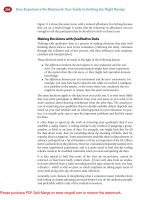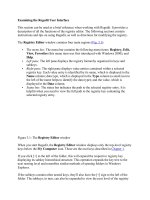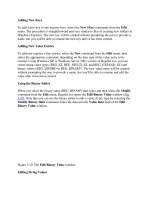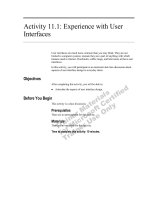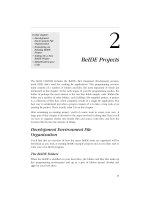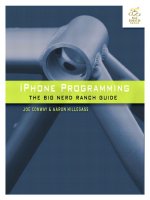Programming the iPhone User Experience docx
Bạn đang xem bản rút gọn của tài liệu. Xem và tải ngay bản đầy đủ của tài liệu tại đây (12.19 MB, 190 trang )
Simpo PDF Merge and Split Unregistered Version -
Download at Boykma.Com
Simpo PDF Merge and Split Unregistered Version -
Programming the iPhone User Experience
Download at Boykma.Com
Simpo PDF Merge and Split Unregistered Version -
Download at Boykma.Com
Simpo PDF Merge and Split Unregistered Version -
Programming the iPhone User
Experience
Toby Boudreaux
Beijing
•
Cambridge
•
Farnham
•
Köln
•
Sebastopol
•
Taipei
•
Tokyo
Download at Boykma.Com
Simpo PDF Merge and Split Unregistered Version -
Programming the iPhone User Experience
by Toby Boudreaux
Copyright © 2009 Toby Boudreaux. All rights reserved.
Printed in the United States of America.
Published by O’Reilly Media, Inc., 1005 Gravenstein Highway North, Sebastopol, CA 95472.
O’Reilly
books
may be purchased for educational, business, or sales promotional use. Online editions
are also available for most titles (). For more information, contact our
corporate/institutional sales department: 800-998-9938 or
Editor: Steven Weiss
Production Editor: Sarah Schneider
Copyeditor: Emily Quill
Proofreader: Sarah Schneider
Indexer: Seth Maislin
Cover Designer: Karen Montgomery
Interior Designer: David Futato
Illustrator: Robert Romano
Printing History:
August 2009:
First Edition.
O’Reilly
and the O’Reilly logo are registered trademarks of O’Reilly Media, Inc. Programming the
iPhone
User Experience, the image of a six-shafted bird of paradise, and related trade dress are trademarks of
O’Reilly Media, Inc.
Many of the designations used by manufacturers and sellers to distinguish their products are claimed as
trademarks. Where those designations appear in this book, and O’Reilly Media, Inc. was aware of a
trademark claim, the designations have been printed in caps or initial caps.
While every precaution has been taken in the preparation of this book, the publisher and author assume
no responsibility for errors or omissions, or for damages resulting from the use of the information con-
tained herein.
ISBN: 978-0-596-15546-9
[M]
1249069920
Download at Boykma.Com
Simpo PDF Merge and Split Unregistered Version -
Table of Contents
Preface . . . . . . . . . . . . . . . . . . . . . . . . . . . . . . . . . . . . . . . . . . . . . . . . . . . . . . . . . . . . . . . . . . . . . ix
1. Cocoa Touch: The Core iPhone . . . . . . . . . . . . . . . . . . . . . . . . . . . . . . . . . . . . . . . . . . . . . 1
Mac Frameworks 1
UIKit Overview 2
Foundation Overview 4
Garbage Collection 9
The Devices 10
2. The Mobile HIG . . . . . . . . . . . . . . . . . . . . . . . . . . . . . . . . . . . . . . . . . . . . . . . . . . . . . . . . 11
The Mobile HIG 12
Enter Cocoa Touch 13
Mobile HIG Concepts 13
Provide One User Experience 13
Provide Seamless Interaction 15
Let the User Know What’s Going On 16
Use Progressive Enhancement 16
Consider Cooperative Single-Tasking 17
A Supplement to the HIG 18
3. Types of Cocoa Touch Applications . .
. . . . . . . . . . . . . . . . . . . . . . . . . . . . . . . . . . . . . . 19
Productivity Tools 20
Limited or Assisted Scrolling 20
Clear and Clean Detail Views 23
Light Utilities 24
Immersive Applications 25
4. Choosing an Application Template . . . . . . . . . . . . . . . . . . . . . . . . . . . . . . . . . . . . . . . . 27
View Controllers 29
View Controller Subclasses and Corresponding Application Templates 30
Core Data Templates 35
v
Download at Boykma.Com
Simpo PDF Merge and Split Unregistered Version -
5. Cooperative Single-Tasking . . . . . . . . . . . . . . . . . . . . . . . . . . . . . . . . . . . . . . . . . . . . . . 37
Task Management and iPhone OS 37
Example Application 38
Launching Quickly 43
Example Application 45
Handling Interruptions 47
Interruptions and the Status Bar 48
Example Application 48
Handling Terminations 51
Example Application 51
Using Custom URLs 52
Using Shared Data 54
Using Push Notifications 55
6. Touch Patterns . .
. . . . . . . . . . . . . . . . . . . . . . . . . . . . . . . . . . . . . . . . . . . . . . . . . . . . . . 57
Touches and the Responder Chain 58
UITouch Overview 58
The Responder Chain 59
Touch Accuracy 62
Size 62
Shape 66
Placement 67
Overlapping Views 68
Detecting Taps 68
Detecting Single Taps 68
Detecting Multiple Taps 69
Detecting Multiple Touches 70
Handling Touch and Hold 70
Handling Swipes and Drags 72
Handling Arbitrary Shapes 74
7. Interaction Patterns and Controls . .
. . . . . . . . . . . . . . . . . . . . . . . . . . . . . . . . . . . . . . . 83
Application Interaction Patterns 83
Command Interfaces 83
Radio Interfaces 84
Navigation Interfaces 85
Modal Interfaces 85
Combination Interfaces 87
UIControl Classes 88
The Target-Action Mechanism 89
Types of Control Events 89
Standard Control Types 91
Buttons 91
vi | Table of Contents
Download at Boykma.Com
Simpo PDF Merge and Split Unregistered Version -
Modal Buttons 98
Sliders 103
Tables and Pickers 106
Search Bars 109
Segmented Controls 111
Scrolling Controls 114
Tables and Embedded Controls 120
Passive Indicators 121
Active Indicators and Control Accessories 122
8. Progressive Enhancement . . . . . . . . . . . . . . . . . . . . . . . . . . . . . . . . . . . . . . . . . . . . . . 125
Network Connectivity 126
Maintain State and Persist Data 126
Cache User Input 127
Reflect Connectivity Appropriately 128
Load Data Lazily 129
Peer Connectivity with GameKit 132
Location Awareness 133
Accelerometer Support 137
Rotation Support 139
Audio Support 140
9. UX Anti-Patterns . .
. . . . . . . . . . . . . . . . . . . . . . . . . . . . . . . . . . . . . . . . . . . . . . . . . . . . 147
Billboards 147
Sleight of Hand 150
Bullhorns 152
App As OS 155
Spin Zone 157
The Bouncer 157
Gesture Hijacking 160
Memory Lapse 161
The High Bar 163
Sound Off 164
Index . . . . . . . . . . . . . . . . . . . . . . . . . . . . . . . . . . . . . . . . . . . . . . . . . . . . . . . . . . . . . . . . . . . . . 167
Table of Contents | vii
Download at Boykma.Com
Simpo PDF Merge and Split Unregistered Version -
Download at Boykma.Com
Simpo PDF Merge and Split Unregistered Version -
Preface
The launch of the iPhone software development kit (SDK) was a big deal for developers,
designers, and consumers alike. Developers and designers were able to access a previ-
ously closed
platform and distribution channel. Consumers were excited to explore an
endless stream of new applications created by passionate independent developers and
innovative companies.
New platforms often suffer from growing pains. Users and application creators learn
simultaneously, with developers releasing applications to the market and users pro-
viding feedback. Different application teams come up with different approaches to
common problems, because agreed-upon, proven solutions take time to emerge. These
growing pains can be compounded when communication within the community is
minimal.
In the case of the iPhone SDK, Apple has famously frustrated both developers and
consumers by imposing a non-disclosure agreement (NDA) that legally restricts the
ability to discuss upcoming features, tools, approaches, and technologies. To compen-
sate for the lack of conversation within the development community, Apple provides
a great set of guidelines for designing and coding iPhone applications.
The Human Interface Guidelines (HIG) describe the way applications should look and
feel on Apple platforms. For the iPhone OS, Apple released a separate version of the
HIG that focuses on mobile, Multi-Touch applications. The HIG works well in many
regards, and it remains a valuable resource for anyone creating mobile applications.
However, the HIG cannot cover all topics that arise in the course of application devel-
opment, nor can it provide insight from the market at large. Questions invariably
emerge: What works for users? What causes frustration? What habits have emerged
that should be avoided? What practices can help small teams or independent developers
use their limited time and resources wisely? Which features should be prioritized for a
shipping product? What do programmers need to know to deliver a great user
experience?
You can think of this book as a supplement to the HIG—a resource that, along with
Apple’s extensive technical documentation, should guide teams through the choices
they must make when embracing a new platform.
ix
Download at Boykma.Com
Simpo PDF Merge and Split Unregistered Version -
Audience for This Book
This book is geared toward designers, developers, and managers who wish to develop
user-friendly applications for the iPhone and iPod Touch. The book mixes technical
and strategic discussions, and it should be approachable by both technical developers
and technology-savvy users.
The code in this book is Objective-C, and an understanding of the language is necessary
to maximize the value of the code examples. If you are a desktop Cocoa developer, this
book will introduce you to the differences between Cocoa and Cocoa Touch, the set
of frameworks for iPhone applications. Managers and experience designers can use this
book to understand the ways that applications can function together to create a holistic
user experience.
Finally, this book is for readers who own and use the iPhone. To create an excellent
iPhone application, a developer must have empathy for iPhone users. An appreciation
of the challenges that face mobile users—both environmental and physical—is
essential.
If you have no prior experience with Objective-C or Cocoa Touch, you may want to
refer to an excellent book by one of this book’s technical editors, Jonathan Zdziarski.
His book, iPhone SDK Application Development (O’Reilly), provides a technical foun-
dation in Objective-C and Cocoa Touch.
Organization of This Book
Chapter 1, Cocoa Touch: The Core iPhone, describes the essential information for Cocoa
Touch and the devices that run the iPhone OS.
Chapter 2, The Mobile HIG, gives an introduction to the Human Interface Guidelines
and elaborates on the most important concepts in the iPhone user experience.
Chapter 3, Types of Cocoa Touch Applications, presents a vocabulary for describing
families of applications for the iPhone and links each to a structural application type.
Chapter 4, Choosing an Application Template, examines the application templates sup-
plied with Xcode and the iPhone SDK. The concept of view controllers is explained
with each type of standard view controller covered.
Chapter 5, Cooperative Single-Tasking, breaks from the application structure and
focuses on the ways applications can work together to create a holistic user experience.
Chapter 6, Touch Patterns, teaches you how to work with the Multi-Touch interface,
including design patterns for standard and custom gestures.
Chapter 7, Interaction Patterns and Controls, covers the types of user interface controls
included in the Cocoa Touch UI framework, and the design patterns used to enable
controls to work together.
x | Preface
Download at Boykma.Com
Simpo PDF Merge and Split Unregistered Version -
Chapter 8, Progressive Enhancement, discusses techniques to layer functionality around
user ability. Networking, data management, rotation, and audio functionality are
addressed.
Chapter 9, UX Anti-Patterns, covers a set of common approaches that can cause issues
for users.
Conventions Used in This Book
The following typographical conventions are used in this book:
Italic
Indicates new terms, URLs, email addresses, filenames, and file extensions.
Constant width
Used for program listings, as well as within paragraphs to refer to program elements
such as variable or function names, databases, data types, environment variables,
statements, keywords, classes, and frameworks.
Constant width bold
Used for emphasis within code examples.
This icon signifies a tip, suggestion, or general note.
Using Code Examples
This book is here to help you get your job done. In general, you may use the code in
this book in your programs and documentation. You do not need to contact us for
permission unless you’re reproducing a significant portion of the code. For example,
writing a program that uses several chunks of code from this book does not require
permission. Selling or distributing a CD-ROM of examples from O’Reilly books does
require permission. Answering a question by citing this book and quoting example
code does not require permission. Incorporating a significant amount of example code
from this book into your product’s documentation does require permission.
We appreciate, but do not require, attribution. An attribution usually includes the title,
author, publisher, and ISBN. For example: “Programming the iPhone User Experience
by Toby Boudreaux. Copyright 2009 Toby Boudreaux, 978-0-596-15546-9.”
If you feel your use of code examples falls outside fair use or the permission given above,
feel free to contact us at
Preface | xi
Download at Boykma.Com
Simpo PDF Merge and Split Unregistered Version -
Safari® Books Online
When you see a Safari
®
Books Online icon on the cover of your favorite
technology book, that means the book is available online through the
O’Reilly Network Safari Bookshelf.
Safari offers a solution that’s better than e-books. It’s a virtual library that lets you easily
search thousands of top tech books, cut and paste code samples, download chapters,
and find quick answers when you need the most accurate, current information. Try it
for free at .
How to Contact Us
Please address comments and questions concerning this book to the publisher:
O’Reilly Media, Inc.
1005 Gravenstein Highway North
Sebastopol, CA 95472
800-998-9938 (in the United States or Canada)
707-829-0515 (international or local)
707-829-0104 (fax)
We have a web page for this book, where we list errata, examples, and any additional
information. You can access this page at:
/>To comment or ask technical questions about this book, send email to:
For more information about our books, conferences, Resource Centers, and the
O’Reilly Network, see our website at:
Acknowledgments
I would like to thank Steve Weiss and Robyn Thomas, my editors at O’Reilly Media,
for their guidance throughout this project. I would also like to thank Chandler
McWilliams and Jonathan Zdziarski for their careful technical reviews, which made
this a more accurate and comprehensive book. Finally, thanks to my wife and son for
their flexibility and support, and for sacrificing weekend trips as I worked on the
project.
xii | Preface
Download at Boykma.Com
Simpo PDF Merge and Split Unregistered Version -
CHAPTER 1
Cocoa Touch: The Core iPhone
Cocoa is a collection of tools—libraries, frameworks, and APIs—used to build appli-
cations for
the Mac OS. Most of the core functionality you would need to develop a
rich Mac application is included in Cocoa. There are mechanisms for drawing to dis-
play, working with text, saving and opening data files, talking to the operating system,
and even talking to other computers across a network. The look and feel of Mac ap-
plications is recognizable and relatively consistent in large part because of the breadth
and quality of the Cocoa user interface framework.
The Cocoa frameworks include two areas of focus: classes that represent user interface
objects and collect user input, and classes that simplify challenges like memory man-
agement, networking, filesystem operations, and time management.
Developing applications for the iPhone and iPod Touch is similar in many ways to
building applications for Mac OS X. The same tools are used for writing and debugging
code, laying out visual interfaces, and profiling performance, but mobile application
development requires a supplemental set of software libraries and tools, called the
iPhone SDK (software development kit).
Cocoa Touch is a modified version of Cocoa with device-specific libraries for the iPhone
and iPod Touch. Cocoa Touch works in conjunction with other layers in the iPhone
and iPod Touch operating systems and is the primary focus of this book.
Mac Frameworks
Mac OS X programmers use a framework called AppKit that supplies all the windows,
buttons, menus, graphics contexts, and event handling mechanisms that have come to
define the OS X experience. The Cocoa Touch equivalent is called UIKit. In addition
to user interface elements, UIKit provides event handling mechanisms and handles
drawing to the screen. UIKit is a very rich framework and is a major focus of user
experience programmers. Nearly all user interface needs are accounted for in UIKit,
and developers can create custom UI elements very easily. Many of the user experience
problems and patterns addressed in this book will focus on UIKit programming with
an emphasis on standard solutions.
1
Download at Boykma.Com
Simpo PDF Merge and Split Unregistered Version -
The second Cocoa Touch framework is the Foundation framework. You can think of
Foundation as the layer that abstracts many of the underlying operating system elements
such as primitive types, bundle management, file operations, and networking from the
user interface objects in UIKit. In other words, Foundation is the gateway to everything
not explicitly part of the user interface. As you’ll see in this book, user experience
programming goes deeper than the user interface controls and includes things such as
latency management, error handling, data caching, and data persistence.
UIKit Overview
The user interface comprises the elements of a device or application that users see, click,
and—in the case of Cocoa Touch—tilt, shake, or tap. User interfaces are a big part of
user experience. They provide the face of your product, and often a bit more.
For the most part, UIKit is just a limited subset of the AppKit framework for Mac OS
X. If you have experience developing Cocoa apps for the Mac, you will get your head
around UIKit fairly quickly. The main differences are that UIKit is tuned for specific
hardware interfaces and that it provides less functionality than AppKit. The reduced
scope of UIKit is primarily due to the differences in robustness between typical com-
puters and the iPhone or iPod Touch. Despite the omission of a few familiar elements,
UIKit is a very capable toolset.
The best way to understand the breadth of UIKit is with a visual topology of the frame-
work. Figures 1-1 and 1-2 show the layout of UIKit.
The core class from which all Cocoa objects inherit basic behavior is NSObject. The
NS prefix has roots in the non-Apple origins of Cocoa at NeXT. The early versions of
what is now Cocoa were called NextStep. Most Cocoa classes in Cocoa are subclasses
of NSObject, and many classes assume that NSObject is the foundation of objects being
passed around. For example, the class NSArray, which represents a collection of point-
ers, requires that any pointer it stores points to an NSObject subclass. In most cases,
any custom class you create should inherit from NSObject.
The names of classes in Cocoa are often very descriptive. The following illustrations
give an overview of the classes in UIKit. The purpose is to provide a view of the entire
collection of classes so that developers of all experience levels can see the breadth of
the frameworks.
In UIKit, all classes that respond to user input inherit from UIResponder, which is an
NSObject subclass that provides functionality around handling user input. Figure 1-1
focuses on the subclasses of UIResponder.
2 | Chapter 1: Cocoa Touch: The Core iPhone
Download at Boykma.Com
Simpo PDF Merge and Split Unregistered Version -
Figure 1-1. UIKit classes: UIResponder tree
In addition to the UIResponder class hierarchy, UIKit
includes a set of classes acting as
value objects, logical controllers, and abstractions of hardware features. Figure 1-2
shows these classes.
The documentation sets that accompany the iPhone SDK, in tandem with the Apple
Developer Connection website, cover all the details of the Cocoa and Cocoa Touch
framework classes. This book will further elaborate on key classes in the context of
interaction design patterns and overall user experience, but the official documentation
should remain the primary reference for developers, as each update to the iPhone SDK
includes amended or edited documentation packages.
Mac Frameworks | 3
Download at Boykma.Com
Simpo PDF Merge and Split Unregistered Version -
Figure 1-2. UIKit classes: controllers, value objects, device classes
Foundation Overview
The Foundation layer
of Cocoa Touch (and Cocoa on the Mac) provides an object-
oriented abstraction to the core elements of the operating system. Foundation handles
core features of Cocoa Touch, including:
• Essential object behavior, such as memory management mechanisms
• Inter-object notification mechanisms, such as event dispatching
• Access to resource bundles (files bundled with your application)
• Internationalization and localization of resources, such as text strings and images
• Data management tools (SQLite, filesystem access)
• Object wrappers of primitive types, such as NSInteger, NSFloat, and NSString
All Cocoa Touch applications must link against Foundation because Foundation con-
tains the classes that make a Cocoa application work—including many classes that are
integral in the functioning of the user interface framework. For example, many UIKit
methods use NSString objects as arguments or return values from methods.
4 | Chapter 1: Cocoa Touch: The Core iPhone
Download at Boykma.Com
Simpo PDF Merge and Split Unregistered Version -
The Foundation class tree as supported by Cocoa Touch is illustrated in Figures 1-3 to
1-9. The class hierarchy diagrams are logically grouped according to coarse function-
ality. This conceptual grouping mirrors the organization used by Apple in the Cocoa
Fundamentals Guide included in the developer documentation. You should consult the
Cocoa Fundamentals Guide and the class documentation provided by Apple as part of
the iPhone SDK install for updated, in-depth information about the framework classes.
Figure 1-3 shows a subset of NSObject subclasses that represent value objects. Value
objects are used to represent non-functional values—primitives, dates, generic binary
data—and to provide utility methods for those values.
Figure 1-3. Value objects
Figure 1-4 maps
the NSObject subclasses that focus on XML and string management.
The XML classes are particularly useful when working with web services. Strings are
used constantly, and Cocoa developers spend a lot of time working with NSString
instances.
Foundation provides powerful classes for collection management. These classes are
shown in Figure 1-5. Standard collection types such as arrays, sets, and hash tables are
included, along with classes used for enumerating through collections.
Mac Frameworks | 5
Download at Boykma.Com
Simpo PDF Merge and Split Unregistered Version -
Figure 1-4. XML and strings
Figure 1-5. Collections
6 | Chapter 1: Cocoa Touch: The Core iPhone
Download at Boykma.Com
Simpo PDF Merge and Split Unregistered Version -
Figure 1-6 illustrates classes that focus on operating system services, file operations,
and inter-process communication (IPC).
Figure 1-6. Operating system services: operations, file operations, interprocess communication
Figure 1-7
illustrates the portion of Foundation that provides for URL handling func-
tionality. Hybrid web/Cocoa applications use URL handling classes heavily.
Figure 1-8 shows the classes used to manage threading in Cocoa applications. Careful
thread management can be an important part of optimizing the perception of respon-
siveness in an application.
Mac Frameworks | 7
Download at Boykma.Com
Simpo PDF Merge and Split Unregistered Version -
Figure 1-7. Operating system services: URL handling
Figure 1-8. Operating system services: locking and thread management
8 | Chapter 1: Cocoa Touch: The Core iPhone
Download at Boykma.Com
Simpo PDF Merge and Split Unregistered Version -
Finally, Figure 1-9 shows classes providing notifications, archiving, and core language
features such as exceptions.
Figure 1-9. Notifications, archiving and serialization, Objective-C language services
Garbage Collection
One notable
difference between the iPhone OS and Mac OS X is that the implemen-
tation of Foundation for Cocoa Touch does not automatically recover memory when
objects are destroyed. This means developers must keep track of the objects they create
and follow certain idioms in order to keep memory usage as low as possible.
The newest version of the Objective-C programming language, version 2.0, added sup-
port for automatic resource management, or garbage collection. Developers who have
grown accustomed to using garbage collection in Cocoa applications on the Mac may
find its omission in the iPhone SDK inconvenient. The performance implications of
most garbage collection implementations are important considerations on mobile
devices, and this is a key reason it was excluded from the iPhone. Battery life and
Garbage Collection | 9
Download at Boykma.Com
Simpo PDF Merge and Split Unregistered Version -
processing speed are important elements of an elegant user experience, and often act
as differentiating factors among competing devices in the consumer marketplace.
The Devices
The screen on both the iPhone and iPod Touch is an LCD-lit 3.5-inch (diagonal) wide-
screen Multi-Touch display. The screen resolution is 480 × 320 pixels at a resolution
of 163 pixels per inch. The devices include the following sensors: accelerometer, prox-
imity sensor, and ambient light sensor.
• When activated, the accelerometer is used to detect device movement in space,
providing information about movement along three axes.
• The proximity sensor recognizes the proximity of the handset to another object,
most commonly a human ear.
• The ambient light sensor detects the level of ambient light hitting the device.
Both the iPhone and iPod Touch devices provide rocker switches for controlling vol-
ume, a hardware power button, and a depressible “home” button. These concrete in-
terfaces are outside the scope of Cocoa Touch programming, but are notable in the
overall UX (user experience) of the devices.
From the point of view of user experience programmers, the hardware interface ele-
ments are separate from the touch interface. Apple doesn’t provide any means of
accessing the home button, lock button, volume controls, or the navigation controls
included on headsets. This simplifies the domain of UX programming, but comes at a
cost: there are certainly cases in which access to the home button or volume rocker
could provide enhanced functionality to users.
The iPhone provides a few distinct advantageous features over the iPod Touch, aside
from the telephony. For example, the iPhone includes GPS support and a hardware
ringer/silence switch. For networking, in addition to 802.11g support, the iPhone 3G
includes support for 3G wireless networking, and support for High-Speed Downlink
Packet Access (HSDPA). The operating system will, unless told otherwise, automati-
cally switch from 3G to wireless networks with known names. This feature is part of a
larger UX pattern that is core to the iPhone: attempting to deliver the best experience
possible given the environment, without interruption. We will cover this pattern in
Chapter 8.
10 | Chapter 1: Cocoa Touch: The Core iPhone
Download at Boykma.Com
Simpo PDF Merge and Split Unregistered Version -
CHAPTER 2
The Mobile HIG
Most large software efforts—especially those allowing any form of extension by devel-
opers—define guidelines
for user experience. These guidelines provide documentation
of the design, interaction, and semantic patterns that define the interaction between
humans and the software in question.
Apple is known for compelling, forward-thinking user experiences. Their tools and
libraries make the creation of third-party software that fits seamlessly into the aesthetics
of the Mac OS X operating system a trivial task. The Mac “look and feel” is something
users recognize and expect from the applications. Apple provides developers and
designers with a set of general Human Interface Guidelines (HIG) to help clarify their
approach and reasoning behind interface decisions.
There has almost always been controversy around the Apple HIG, leading some inde-
pendent developers to proclaim the Apple HIG a “dead” document. Most of this has
been due to Apple stepping outside their own recommendations and guidelines, and
has thus created three tiers of applications: those by Apple, those by developers who
follow the HIG, and those by developers who ignore the HIG (think Java and Swing
applications).
The benefits of designing within the boundaries of the HIG are significant for both
customers and developers. Users can learn to interact with an application much faster
when the design of the interface follows familiar conventions. The Mac look and feel
is skewed toward first-time or casual users. For frequent power users, progressive en-
hancement techniques are used to add options and customization without alienating
newcomers. When done properly, progressive enhancement adds depth, rather than
breadth, to the user experience.
Software producers benefit in many ways as well. Development is quicker because a
rich set of standards can allow developers to focus on the unique elements of an
application instead of fretting over and excessively prototyping common layouts and
visual effects. The same is true for decisions about features. The HIG describes a layered
structure for prioritizing functionality and design. When making design decisions or
focusing on implementation, the recommendation is to focus first on the minimum
11
Download at Boykma.Com
Simpo PDF Merge and Split Unregistered Version -

